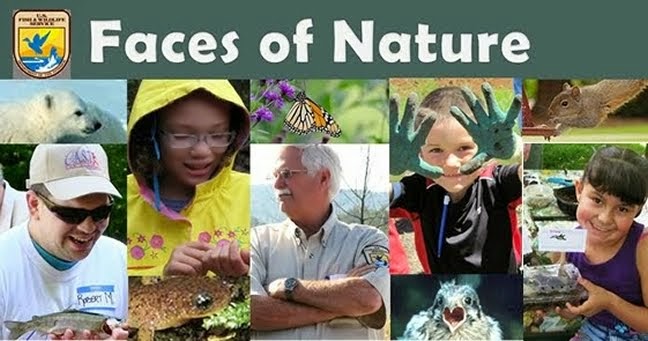"Must we always teach our children with books? Let them look at the stars and the mountains above. Let them look at the waters and the trees and flowers on Earth. Then they will begin to think, and to think is the beginning of a real education." - David Polis
 |
| Finley NWR biolgist, Nate teaches the kids how to identify different species of birds using their physical markings. Credit: Meghan Kearney/USFWS |
 |
| The kids get a close-up look at some of the waterfowl that can be spotted throughout the refuge. Credit: Meghan Kearney.USFWS |
As we approached the first station, the kids were quick to notice a small cotton sack attached to a table. It seemed to be pulsating with what you could almost make out as flaps of tiny wings eager to escape. Our station host, refuge biologist Nate, carefully removed a small and adorable bird from the pouch, pointing to the bird's fluffy white belly. Physical markings such as these, he explained, could help identify different types and sexes of birds.
Next, the group moved on to the waterfowl identification station where they were asked to first observe a display of birds from afar before moving in to get an up-close look at the birds' physical features. Taking notes in their field guides, the children discussed the similarities and differences of each of the different birds.
 |
| Elk bones spotted nearby Woodpecker Loop Trail. Credit: Meghan Kearney/USFWS |
Hitting the trails
The rest of our day included two trail hikes, one through the refuge's upland forest along Woodpecker Loop Trail, and the other around the large wetland area - Cabell Marsh. Along Woodpecker Loop, our guide, volunteer Mike, explained the history of the refuge using folklore-like stories dispersed with references of the local rivalry between college football teams the Oregon Ducks and Oregon State Beavers. Halfway in, we took a detour to a recently discovered elk skeleton found just off of the path. "He must have been a Beaver fan," Mike joked. It took about three pokes at the university rivalry before the kids caught on, but when they did, connecting football and nature seemed to make learning even more exciting.
 |
| Taking a pit stop along the trail to check out the nature surrounding us. We even spotted a beaver dam! Credit: Meghan Kearney/USFWS |
After a lunch in the sun, our next stop took us along a path scattered with remnant fruit trees before reaching Cabell Marsh. Luckily, the kids got plenty of fresh fruit before arriving at the marsh, which I will soon explain was no easy task for our stomachs.
As we entered the currently dried up marsh, enough so that we could walk along its base, our new guide, volunteer Lowell, explained the reasoning behind this occurrence. Every few years, invasive carp overpopulate the marsh, destroying habitat for migrating birds. During the off-season, the marsh is drained to kill off all of the inhabiting carp, as well as invasive bull frogs. This allows the marsh to flourish and provide nutrients for numbers of different bird species; although in time the carp and bull frogs will likely make their way back and another draw down will be needed.
 |
| One of the many animal tracks we discovered in the damp basin of Cabell Marsh. Credit: Meghan Kearney/USFWS |
Our visit to the refuge was just in time to witness with our eyes, but especially our noses, the piles of dried up carp along the shore. Some of us pulled our shirts up over our noses, while others, eager to brave the stench moved in for a closer look. "Oh, come on! It isn't that bad!" one of the kids yelled at his friends as he bent down to notice a giant pile of scurrying tadpoles on the surface of a small carp-saturated puddle, the last of the marsh's water supply. The smell alone was enough to help us all remember the harmful nature of these invasive fish! The drained-out marsh also provided a wide haven of slightly wet ground; just wet enough to assure any passing animals would leave behind beautifully defined tracks.
 |
| We also spotted a number of different frogs still inhabiting parts of Cabell Marsh. The kids were eager to catch some and get a better look. Credit: Meghan Kearney/USFWS |
Through the eyes of pioneers
After scooping baby frogs, noting elk and beaver tracks, and later spotting a beaver dam, we headed off to our final stop of the day; an historic pioneer house. Gail, refuge volunteer and organizer for Outdoor Experience took us room-by-room through the house, explaining its history and its need for preservation. Looking at old family photos lining the walls, the kids pictured themselves as pioneer children living off the nearby fruit trees that we had earlier indulged in. Our full-circle tour of Finley NWR had come to a close, leaving us with memories of up-close and personal encounters with elk bones, berries, and a few smelly fish. We left, most importantly, with a new appreciation for the natural world at our fingertips.
Fun related links:

